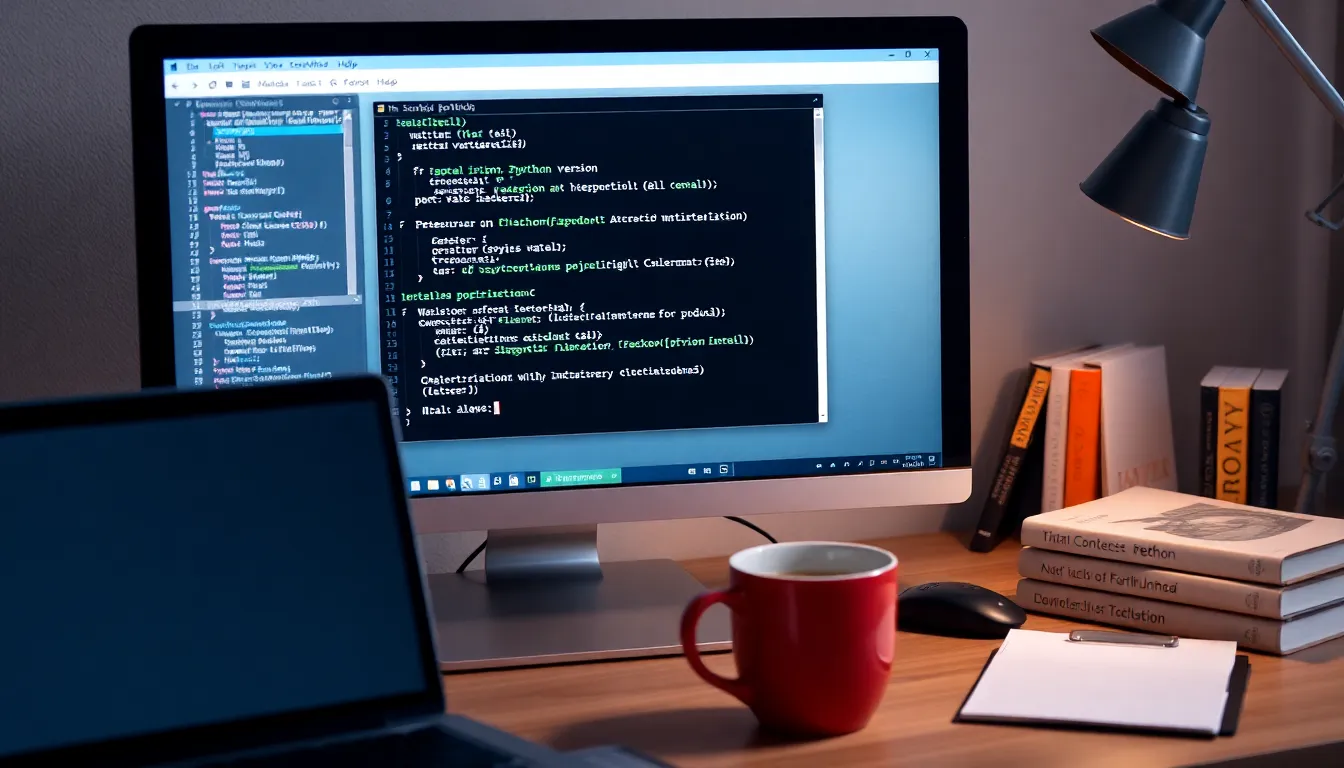In a world where speed is king, Python multiprocessing is like adding rocket fuel to your code. If you’ve ever felt the frustration of waiting for your program to finish while sipping coffee, it’s time to embrace the magic of parallel processing. Imagine running multiple tasks simultaneously, freeing up valuable time for more important things—like binge-watching your favorite series or perfecting your coffee brewing skills.
Table of Contents
ToggleOverview Of Python Multiprocessing
Python multiprocessing allows execution of multiple tasks simultaneously, significantly improving program efficiency. This module creates multiple processes, each running in its own Python interpreter. Users often find this approach essential for CPU-bound operations, where tasks demand substantial processing power.
Various components comprise the multiprocessing module. The Process class enables the creation of individual processes, while Queue and Pipe facilitate data sharing between them. Developers utilize Pool for managing multiple worker processes, making parallel execution more straightforward.
Key advantages enhance performance. By distributing workload across different CPU cores, Python multiprocessing can significantly reduce execution time. Users often notice faster program responses, particularly in data-heavy applications.
Consider a scenario where one needs to process large datasets. Multiprocessing distributes data tasks to different processors, making it possible to retrieve results quicker than with single-threaded processing. For example, handling multiple image processing tasks benefits greatly from multiprocessing, resulting in quicker image manipulation and rendering.
In addition to performance gains, multiprocessing aids in improving responsiveness. Executing tasks concurrently allows applications to stay responsive, as long-running tasks don’t block the main execution thread. This approach proves beneficial in user interface applications.
Developers must also handle challenges like inter-process communication. Effective communication methods, such as shared memory and messaging systems, ensure organized data flow between processes.
Understanding workflow management within Python multiprocessing becomes crucial for maintaining organized code structure. By mastering this module, programmers can elevate their applications, achieving significant performance gains.
Setting Up Your Environment

Setting up the environment for Python multiprocessing involves ensuring the right libraries are available and properly installing them.
Required Libraries
The primary library for multiprocessing in Python is the built-in multiprocessing module. It provides essential functions and classes to facilitate parallel processing. Additionally, other libraries like numpy and pandas enhance data handling, especially for larger datasets. Both libraries support efficient numerical and data manipulation, making them valuable for multiprocessing tasks.
Installation Process
To get started, first, confirm you have Python installed. Most systems come with Python pre-installed, but checking the version matters. Use python --version or python3 --version in the terminal. When lacking the multiprocessing module, it’s not necessary to install it separately. However, for libraries like numpy or pandas, utilize pip, Python’s package manager. Run pip install numpy pandas to install them. Following this, verify the successful installation by importing these libraries in Python scripts.
Core Concepts Of Multiprocessing
Python multiprocessing significantly elevates the performance of programs by leveraging the ability to run tasks concurrently. Understanding its core components enhances developers’ proficiency.
Processes vs Threads
Processes operate independently with their own memory space. Threads share memory space within a single process, making them lightweight alternatives. Creating multiple processes via the Process class in the multiprocessing module enables true parallelism. Tasks allocated to different processes do not interfere with each other, improving reliability in CPU-bound tasks. By contrast, threads can suffer from issues related to shared resources. Multiprocessing proves beneficial in scenarios that demand high processing power, particularly during data-intensive operations. Developers appreciate the distinction between the two, as it influences performance outcomes.
Global Interpreter Lock (GIL)
GIL restricts the execution of multiple threads in a Python process, allowing only one thread to execute at a time. This limitation affects performance, particularly in CPU-bound scenarios. Although GIL can be circumvented using multiprocessing, it remains a crucial factor in thread management. Python’s design prioritizes ease of use, often favoring simplicity over full parallel processing. Developers utilizing multiprocessing can bypass GIL’s constraints, fully optimizing their application’s capabilities. Understanding GIL facilitates informed decisions regarding the choice between multiprocessing and multithreading for achieving desired performance.
Creating Your First Multiprocessing Program
Creating a simple multiprocessing program in Python allows users to explore parallel processing capabilities effectively.
Writing a Simple Script
A basic script demonstrates how to utilize the Process class from the multiprocessing module. First, import the necessary libraries. Next, define a function that performs a specific task. For instance, a function could print numeric values from one to five. After defining the function, create a Process object, passing the target function as an argument. Finally, start the process and join it to ensure completion. This setup allows users to grasp the fundamentals of multiprocessing while executing tasks concurrently.
Running Multiple Processes
Running multiple processes enhances efficiency significantly. To achieve this, define multiple functions or use the same function with different arguments. Instantiate several Process objects for each task. Starting these processes simultaneously promotes parallel execution. Joining each process ensures they complete before moving forward in the script. This approach showcases how Python can effectively utilize system resources, thus improving performance across various applications.
Advanced Multiprocessing Techniques
Advanced techniques in Python multiprocessing enhance efficiency and scalability in applications. Understanding how to effectively share data and synchronize processes is crucial for maximizing performance.
Sharing Data Between Processes
Sharing data between processes requires careful consideration due to their independent memory spaces. The multiprocessing module provides two main mechanisms: Queue and Pipe. Queue offers a thread-safe way to exchange information, while Pipe establishes a two-way communication channel. He or she can implement Queues for simple data transfer, enabling one process to put data into the queue while another retrieves it. Using Pipe allows for a more direct exchange, useful for low-latency communication needs. Both methods facilitate inter-process communication, ensuring that processes can collaborate efficiently on shared tasks.
Process Synchronization
Process synchronization maintains order and consistency when multiple processes access shared resources. The multiprocessing module supplies several synchronization primitives, such as Locks, Semaphores, and Events. Implementing Locks prevents processes from altering shared data simultaneously, reducing the risk of data corruption. Semaphores assist in managing access limits to certain resources, providing a signaling mechanism. Events allow one process to signal another, enabling them to wait for certain conditions before proceeding. By employing these synchronization techniques, a developer ensures smooth operation and integrity in multiprocessing scenarios.
Best Practices For Python Multiprocessing
Implementing best practices in Python multiprocessing leads to smoother performance. Adopting effective strategies ensures efficient execution and reliability.
Error Handling
Handling errors effectively in multiprocessing is crucial. Use try-except blocks within processes to catch exceptions early. Logging errors aids in tracking issues during execution. Propagating exceptions to the main process simplifies debugging later. Ensure to handle specific exceptions for better clarity when diagnosing problems.
Debugging Tips
Debugging multiprocessing code can be challenging due to separate process spaces. Utilizing the logging module keeps track of process activities clearly. Print statements can help visualize the flow, but they may not capture output from all processes. Tools like pdb provide interactive debugging, though you may encounter limitations. Running processes with reduced concurrency levels allows for easier tracking of issues.
Mastering Python multiprocessing opens up a world of possibilities for developers looking to optimize their applications. With the ability to run tasks in parallel and leverage multiple CPU cores, users can significantly reduce execution time and enhance overall program responsiveness.
By understanding the core concepts and implementing best practices, developers can harness the full potential of multiprocessing. Whether it’s through effective data sharing or process synchronization, the right techniques can lead to smoother and more efficient applications.
As they continue to explore Python’s capabilities, embracing multiprocessing will empower them to tackle complex tasks with confidence and creativity.



